Alien Autopsy Face-Off 2
"Alien Autopsy" vs. the Real Thing
Herein we present a few selected comparisons between the "alien
autopsy" and stills from documentary videos of army autopsy
procedures and mortuary techniques.
"Eww, gross! Why are you showing us this?"
Occasionally we get email telling us we shouldn't try to compare
the "alien" to a human because alien corpses are
different from human corpses. (Although they never tell us
how they know this!)
Actually we agree. If this film is any guide, then alien
corpses and human corpses are indeed very different. However,
alien corpses and special FX dummies are strikingly
similar!
Our answer to the "aliens are different" argument
is: the "alien" has humanoid musculature, and
apparently a humanoid bone structure. And for a
terrestrial-style skeleton and muscle system to work,
semi-elastic skin is required. Otherwise, the creature can't
move. (Unless you think the alien has a jointed exoskeleton?)
Anyway, we think that no matter where the thing came from, if
it's a real humanoid, it oughta look like a humanoid when it
gets autopsied. Which it doesn't.
Or maybe you're one of the folks who wonders if the film used
a real human corpse as a stand-in for an alien - maybe you'll
want to consider this page from that perspective instead.
NOTE: This
page is not
for the squeamish!
(or those who think the "Alien
Autopsy" looks realistic!)
Ready? Then scroll down... 
|
Examining the body
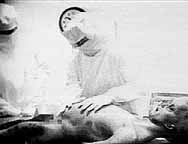
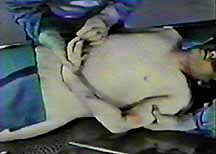
Left: The examiners handle the alien as if it were a
live hand grenade.
Right: In the Army How-To video, the examiners flip the
body
around like Julia Child preparing to filet a trout.
(The picture above right is just the beginning of the Army
video's "external exam" demonstration - we've spared
you the rest, especially the charming genital/anal examination
sequence. You're welcome.)
Unfortunately, still pictures don't properly convey two very
obvious differences between the two "exams":
- First, you must move the body, both in the
preliminary exam and the autopsy itself, in order to do a
proper procedure.
Second, when any part of a human corpse is moved, the rest of
it moves as well. (For example, in the picture above, the
lifting of the left arm shifts the body to the right, causing
the neck to flex, and so on.)
But the "doctors" in the alien video manage to do an
entire autopsy without once moving the body. Have military
autopsy techniques changed that much between 1947 and 1961, when
the "How-To" film was made by the Army?
Or...maybe they don't move the alien because it's a dummy
without real bones, muscles and skin - and it'll look terrible
if they move it?
|
How do you hold your cutting tool?
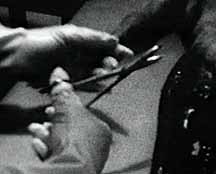
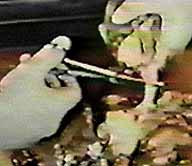
Left: The "alien autopsy" way - thumb and
index finger.
Right: The pathologist's way - thumb and middle finger.
This is not a matter of personal choice - the method at left
is just plain wrong. (Ask a
pathologist).
|
Skin and muscle sags
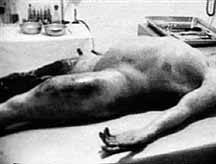
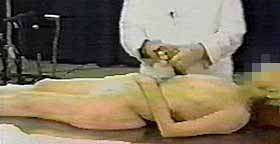
- Compare the roll of fat above the hips in both pictures.
The alien's is elevated, and overlaps the upper thighs. The
human's stretches down toward the table.
- The alien's buttocks are apparently tensed, raising the
body off the table. The human's buttocks are relaxed and the
flesh is flattened against the table.
- The alien's thigh muscles also appear tensed and rounded as
if still alive. The human's thigh muscles sag downward, and
the bones of the leg are in prominent relief.
All of which makes sense if the alien corpse is the result of
a body-cast on a standing, living subject.
|
Skin Incisions
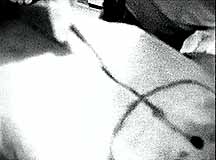
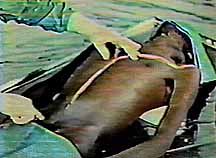
Left (alien) - skin doesn't retract spontaneously when
cut. Bleeding is dramatic but unrealistic.
Right (human) - skin retracts spontaneously when cut.
Lack of bleeding is realistic but undramatic.
A good example of skin elasticity, and the alien's lack
thereof.
The Army video also demonstrates the standard incision
technique - a single, aggressive cut, rather than three
tentative cuts as seen in the "alien" video.
Note also the use of a "body block" under the corpse
at right. The body block has been standard pathologist's
equipment since Michaelangelo's day - its purpose is to elevate
the chest for easier examination.
(Unless you're autopsying an alien, of course, in which case
[insert your favorite rationalization here].)
Our rationalization? A dummy wouldn't flex properly
around a body block unless the original human subject was
body-cast in the same position - something the hoaxers
apparently didn't think of doing. Too bad - it would have made
the end result much more convincing! Or - perhaps their autopsy
homework was incomplete and they simply didn't know
about body blocks (or how to properly hold the scissors...)
NOTE: Don't just take OUR word on this - many of the
above observations were originally pointed out by
Ed Uthman, MD in
a
USENET
post.
For more info about real-world autopsies, check out Uthman's
Autopsy FAQ
- a step-by-step guide to autopsy procedure.
|
|